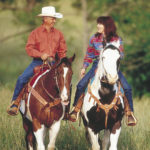Basic gear:
Bridle. Recommended is a nylon or biothane bridle which is washable, durable and inexpensive (under $50), plus snap-on reins that convert quickly to a lead shank. Reins should not be?biothane, which doesn’t provide enough grip, or leather, which isn?t safe to tie with. Rough-surfaced nylon or cotton rope and cotton webbing are okay.?To your bridle, attach an ?attention-getting? bit, slightly stronger than you use in the ring–for instance, a slow-twist snaffle if your ring riding bit is smooth.
Saddle. Your current Western or English saddle might work fine–but if you trail ride often, consider a saddle made specifically for trail riding.

Saddle pad. An all-purpose pad in natural or synthetic fleece or cotton fiber works well; make sure it extends out far enough from your saddle to prevent water bottles, cantle packs, or other attachments from chafing.
Sponge. Enclosed in a net bag, it can be attached to one of the saddle?s D-rings by means of a long string and a clip.
Halter and lead rope. Unless you use a convertible halter/bridle, you’ll need a good-fitting halter and a lead rope to tie your horse safely.
Spare stirrup leather. In case yours breaks on the trail.
Full chaps. These protect your legs from thick, high brush or dense woods, and improve your grip, but can be clumsy for mounting from the ground.
Seat pad. A seat pad cushions your rear on long rides; and protects your saddle from scratching.
This information was adapted from an article by Sandra Cooke in Practical Horseman magazine for the Tractor Supply Company’s “Trail Riding Essentials.”





